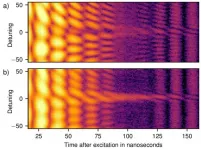(Press-News.org) Recreational hunting -- especially hunting of charismatic species for their trophies --raises ethical and moral concerns. Yet recreational hunting is frequently suggested as a way to conserve nature and support local people's livelihoods.
In a new article published in the journal One Earth, scientists from the University of Helsinki in Finland and Flinders University in Australia have reviewed more than 1,000 studies on recreational hunting -- the first such attempt to summarize the scientific literature examining the biodiversity and social effects of recreational hunting globally.
Co-lead author University of Helsinki Associate Professor Enrico Di Minin says while it might seem counterintuitive, there is evidence to suggest some recreational hunting can deliver environmental and social benefits.
University of Helsinki colleague and co-lead author Dr Hayley Clements says more analysis is needed to understand how and why recreational hunting can work for good, and those areas where it can be detrimental.
Flinders University Professor Corey Bradshaw says it's a paradox that goes to the heart of the pros and cons of recreational hunting.
"We determined the geographic spread and diversity of species hunted around the globe, and investigated and summarized the main topics surrounding recreational hunting to consider both the positive and negative implications of recreational hunting for nature conservation and the livelihoods and well-being of people" says Professor Bradshaw, who leads Flinders' Global Ecology Lab.
"On the one hand, recreational hunting can reduce the number of individual animals in a population, whereas on the other, diverting land from agricultural or other types of development to priority hunting areas can in fact benefit entire ecosystems", he says.
Hunting research has focused mainly on the behaviour and population dynamics of large mammals in North America, Europe and Africa.
Dr Clements says evidence is still lacking, however, to answer the pressing questions of why hunting contributes to sustainable conservation of biodiversity in some places and not others.
"Two-thirds of the hunting research is focussed on mammals. Red deer, white-tailed deer, wild boar, moose and lion are the most well-studied. Of these species, only the lion is of conservation concern, with many recommendations on how hunting can be made sustainable through quotas or seasonal limits", says Dr Clements.
"Far less research has tried to examine the broader impacts of hunting on ecosystem integrity and function, and how it affects the livelihoods of local people, or to document local people's perceptions about hunting", she continues.
For example, approximately 1,394,000 km2 of land is dedicated for trophy hunting in sub-Saharan Africa, yet there is little research on how effective these areas are in conserving ecosystems, and how local communities benefit from hunting.
Associate Professor Di Minin, who leads the Helsinki Lab of Interdisciplinary Conservation Science contends future research should focus on the contribution of recreational hunting towards meeting both biodiversity and social objectives.
"We have outlined a research agenda to assess the role of recreational hunting in diverse social-ecological systems, and to consider local people's values and needs.
The need for such evidence is urgent given declining numbers of recreational hunters in some regions and increasing opposition to trophy hunting in others", says Associate Professor Di Minin.
"We should also expand research beyond charismatic and common species to assess the impact of recreational hunting on threatened and less charismatic species", he concludes
INFORMATION:
Article reference:
Di Minin, Enrico; Clements, Hayley; Correia, Ricardo; Cortés-Capano, Gonzalo; Hausmann, Anna; Haukka, Anna; Kulkarni, Ritwik; Bradshaw, Corey J. A. Consequences of recreational hunting for biodiversity conservation and livelihoods. One Earth doi: 10.1016/j.oneear.2021.01.014.
Creating "super soldiers" of specific white blood cells to boost an anti-tumour response has been shown in a series of elegant experiments by Princess Margaret researchers.
Research led by Ph.D. candidate Helen Loo Yau, Post-doctoral fellow Dr. Emma Bell and Senior Scientist Dr. Daniel D. De Carvalho describes a DNA modifying epigenetic therapy that can transform immune killer T-cells into "super soldiers" by boosting their ability to kill cancer cells.
Their findings could potentially enhance immunotherapy, a new paradigm in cancer treatment currently effective for a minority of cancer patients. Some patients respond well to immunotherapy, with their tumours drastically shrinking in size, but others respond only partially or not at all. Clinicians and scientists around ...
At some point, microvehicles that are small enough to navigate our blood vessels will enable physicians to take biopsies, insert stents and deliver drugs with precision to sites that are difficult to reach, all from inside the body. Scientists around the world are currently researching and developing suitable microvehicles. In most cases, they are powered and controlled by acoustic and magnetic fields or using light. However, until now, propelling microvehicles against a fluid flow had proved to be a major challenge. This would be necessary for the micromachines to be able to navigate in blood vessels against the direction of blood flow. Researchers at ETH Zurich have now developed microvehicles ...
The latest observations from Insight-HXMT were published online in Nature Astronomy on Feb. 18. Insight-HXMT has discovered the very first X-ray burst associated with a fast radio burst (FRB) and has identified that it originated from soft-gamma repeater (SGR) J1935+2154, which is a magnetar in our Milky Way.
Insight-HXMT is the first to identify the double-spike structure of this X-ray burst as the high energy counterpart of FRB 200428. This discovery, together with results from other telescopes, proves that FRBs can come from magnetar bursts, thus resolving ...
From atomic clocks to secure communication to quantum computers: these developments are based on the increasingly better control of the quantum behaviour of electrons in atomic shells with the help of laser light. Now, for the first time, physicists at the Max Planck Institute for Nuclear Physics in Heidelberg have succeeded in precisely controlling quantum jumps in atomic nuclei using X-ray light. Compared with electron systems, nuclear quantum jumps are extreme - with energies up to millions of times higher and incredibly short zeptosecond processes. A zeptosecond is one trillionth of a billionth of a second. The rewards include profound insight into the quantum world, ultra-precise nuclear clocks, ...
Before life emerged on Earth, many physicochemical processes on our planet were highly chaotic. A plethora of small compounds, and polymers of varying lengths, made up of subunits (such as the bases found in DNA and RNA), were present in every conceivable combination. Before life-like chemical processes could emerge, the level of chaos in these systems had to be reduced. In a new study, LMU physicists led by Dieter Braun show that basic features of simple polymers, together with certain aspects of the prebiotic environment, can give rise to selection processes that reduce disorder.
In previous publications, Braun's research group explored how spatial order could have developed in narrow, water-filled chambers ...
Epileptic activity originating from one or more diseased brain regions in the temporal lobe is difficult to contain. Many patients with so-called temporal lobe epilepsy often do not respond to treatment with anti-epileptic drugs, and the affected brain areas must therefore be surgically removed. Unfortunately, this procedure only gives seizure freedom to about one third of patients, so the development of alternative therapeutic approaches is of great importance. Scientists led by neurobiologist Prof. Dr. Carola Haas, head of the research group at the Department of Neurosurgery at Medical Center - University of ...
The major direct and indirect effects of covid-19 have forced the authorities to implement policies that strike a balance between minimizing the immediate health impact of the pandemic and containing the long-term damage to society arising from protective policies.
One parameter that is crucial for calculating how restrictive policies might be warranted is the mortality impact of covid-19, which has led to large-scale international collaborations in order to collect data that records deaths attributable to the pandemic.
Despite the limitations, each of these research avenues and associated health measures (infection rate, deaths and excess deaths) is important in order to inform the public and policymakers about the mortality impact of covid-19.
"Our results confirm that the mortality ...
When can tuberculosis therapy be stopped without risk of relapse? Doctors are faced with this question time and again, because the lack of detection of the tuberculosis pathogen Mycobacterium tuberculosis is no guarantee for a permanent cure of the lung infection. Patients who respond to the standard therapy may be out of treatment after six months. But for resistant cases, more than 18 months of treatment duration is currently advised. "This is a very long time for those affected, who often have to take more than four antibiotics every day and suffer from side effects", explains Prof. Dr. Christoph Lange, Clinical Director at the Research Center Borstel and director of the study, conducted at the German Center for Infection Research (DZIF) in cooperation with the German Center for ...
A group of researchers has developed a new program showing participation and activity is critical for the rehabilitation of older adults in long-term care.
The results of their research were published in the journal PLOS ONE on February 12, 2021.
"Our study shows participatory programs that encourage elderly patients to be active need greater emphasis in elderly care centers," said Yoshihiko Baba, lead author of the study.
In 2015, the Ministry of Health, Labour and Welfare of Japan launched a comprehensive plan to care for the country's aging population. Crucial to this was rehabilitation centered on promoting activities that elderly patients could actively take part in.
Baba, a former ...
Although amber looks like a somewhat unusual inorganic mineral, it is actually derived from an organic source - tree resins. Millions of years ago, when this aromatic and sticky substance was slowly oozing from coniferous trees, insects and other biological material could become trapped in it. That is why some samples of amber contain fossilized specimens, preserved in a virtually pristine state, which afford fascinating snapshots of the flora and fauna of long-gone forests. Now, a research team led by LMU zoologists Viktor Baranov and Joachim Haug has made exciting ...





